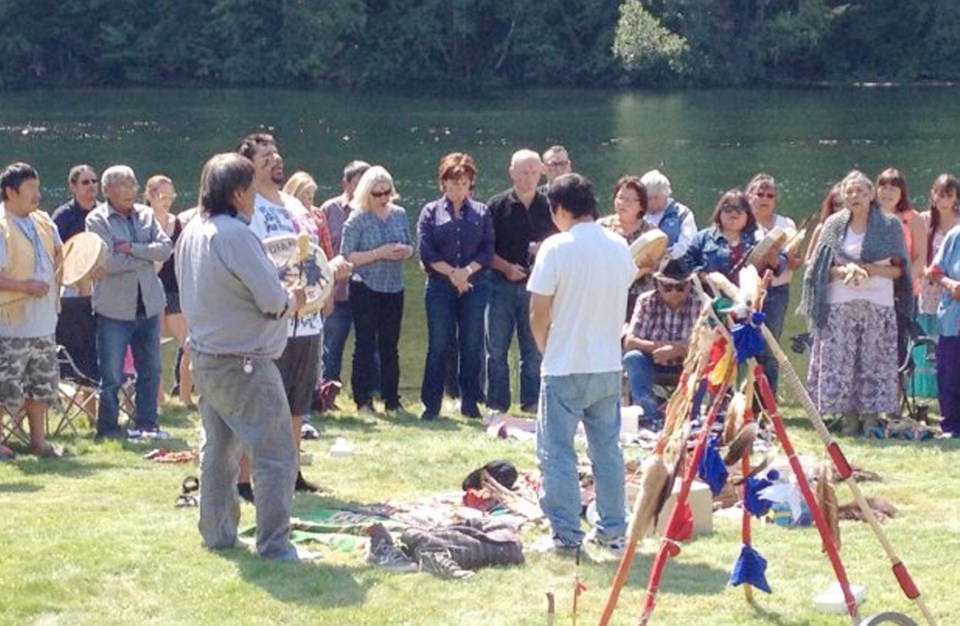B.C. Mines Minister Bill Bennett says the Mount Polley tailings dam collapse is not an environmental disaster, equating it to the “thousands” of avalanches that happen annually in B.C.
Bennett, pointing to initial positive water readings, asserted his contention will be proven in the next several weeks.
Central B.C. First Nations, some area residents and Williams Lake mayor Kerry Cook have described the collapse of the dam as an “environmental disaster.”
The Aug. 4 collapse of a 300-metre section of the gravel and earth dam spewed 10 million cubic metres of water and 4.5 million cubic metres of finely ground up rock containing potentially toxic metals into Hazeltine Creek, Polley Lake and Quesnel Lake.
While the water readings in Quesnel Lake and Quesnel River have been positive, some residents, First Nations and environmentalists have raised concerns over the long-term effects of the sludge that poured into Hazeltine Creek and Quesnel Lake. It will also take longer to determine the environmental effects of the spill, including on salmon, they say.
Bennett acknowledged the dam collapse may be a mining industry, a geotechnical and a political disaster.
But he said that has to be separated from the environmental effects.
“Get up in a helicopter and go and look at the avalanches that happen in this province — there are probably 10,000 or 15,000 avalanches that happen every single year. Get up in a helicopter and go and look at what happened last spring with the events in the Rockies with water coming down and doing exactly what happened in Hazeltine Creek. The difference is that snow melts, (but) you are left with exactly the same (result) — it looks exactly the same as what happened in Hazeltine Creek,” said Bennett.
“It’s a mess. It’s a total mess, there’s no question about that ... What’s going to happen here, is we are going to be left with this opportunity to learn from this huge, profound mistake that’s been made here,” he said.
Bennett made his comments to The Vancouver Sun following the release of water-test results Saturday.
It was the third set of results that showed water met B.C. and Canadian water guidelines for metals such as arsenic, copper, mercury and selenium.
An E. coli test result (that passed guidelines) was also released Saturday for the mouth of Hazeltine Creek, the sample closest to where the water and tailings spilled into Quesnel Lake. The results for metals testing on the Hazeltine Creek water sample were not available by Monday.
Jay Ritchlin, the western region director general for the David Suzuki Foundation, said while there’s little doubt the dam collapse was “bad” and that it will require longer-term monitoring to determine its effects, he saw little use in arguing whether it was an environmental disaster.
Instead, said Ritchlin, the province should use the incident as a learning lesson.
He said the industry has to raise its environmental standards.
“It’s not a question of the sky is falling or the mining industry should be shut down, but we know that tailings management has advanced to the point that most really sophisticated mines dry and stack their tailings,” Ritchlin said. “They just don’t build the mud walls and put a bunch of wet, toxic soup behind it anymore.”
John Werring, senior science adviser with the David Suzuki Foundation, said he believed the dam collapse was an “environmental disaster” for the Hazeltine creek area, as the entire rich vegetation zone along its banks had been wiped out and along with it, the mammals, birds, amphibians and fish.
He argued for long-term monitoring, as well as for additional monitoring of chemicals toxic to fish called zanthates that are used in the mine milling process. (The Ministry of Environment did not immediately have an answer Monday on whether they were testing for zanthates).
Werring said he was also concerned about the effect on spawning sockeye salmon that will pass the area adjacent to Hazeltine Creek where tailings sediments poured into Quesnel Lake.
It could affect their physiology and their ability to find their spawning streams, he said.
Carl Walters, a professor emeritus at the University of B.C.’s Fisheries Centre, said he doesn’t believe the effects on spawning sockeye are likely to be great.
He noted that the main sockeye spawning tributaries enter Quesnel Lake well upstream of where the spill entered the lake. “The water sampling support my estimation that the nasty chemicals and slit were seriously diluted upon entry to Quesnel Lake,” he said.
Fisheries biologist Richard Holmes, who lives in the community of Likely located next to the Quesnel River near Mount Polley mine, noted there are reports that some of the outflow from the spill has been pushed up the lake. Holmes said while he believes the large amount of water in Quesnel Lake will minimize the damage, more monitoring is needed to determine effects on fish.
First Nations in the area, who state they don’t believe the government’s water tests, say they are going to begin testing salmon in the Mount Polley mine area to see if they are safe to eat.
“I challenge anyone to come up to our territory and look at this disaster and say everything is fine,” said Williams Lake Indian Band chief Ann Louie.



